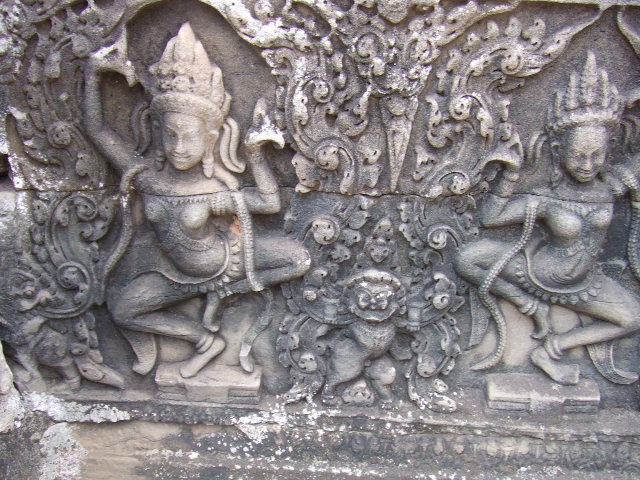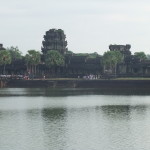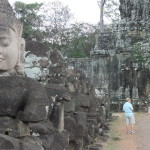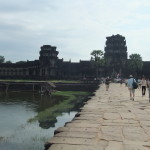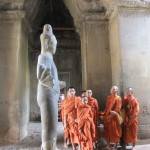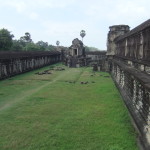
The sky is lightening. Squint and you can just about make out a change in the colour of it, a shift from inky-black to blue-black. As the sun rises further it changes more, until it pales enough behind the stonework that you can begin to make out a hulk on the horizon.
You breathe in and get ready to experience one of travel’s true once-in-a-lifetime moments. And then a selfie stick springs up in your eye line, a bright screen illuminating the darkness. You are jostled from behind and suddenly you can’t see a thing. The stone pinkens in the sunrise ahead but you’re marooned the wrong side of the camera-swayers. You miss the window, those crucial moments, in which Angkor Wat is at its most beautiful.
Yes, there is very much a wrong way to do Angkor Wat. It’s Cambodia’s most visited tourist attraction with more than two million cameras-on-legs passing through every year. But do it right and you can have it to yourself. Find out how below, but remember: it’s a secret.
Ta Prohm Courtyard commons.wikimedia.org
How to avoid the crush at the big three
Angkor is not just one temple, but a complex of hundreds spread over a vast area that was once a city home to more people than London. To most visitors though it is three temples at most: Angkor Wat, the Bayon, and Ta Prohm.
First up is Angkor Wat, the iconic temple whose name is often confused with the name of the complex as a whole. Although you’ve seen this a thousand times on film and in pictures, nothing can prepare you for the beauty of its five perfectly aligned towers, each one like corn on the cob.
Nothing can prepare you for the crowds at the West Gate come sunrise either and these are best avoided. Get your guide to take you to the East Gate instead and you’ll walk through the temple from its backside, scuffing along empty stone corridors in the dark and wondering where everyone else is. Watch the sunrise from here, lighting up the stones as it ascends, before heading out of the West Gate for coffee and breakfast at one of the stands nearby.
By the time you’re finished, the worst of the sunrise crowds will have gone but it will still be early enough to explore in relative peace
The Bayon, with its pyramid covered in hundreds of half-smiling faces, is packed from sun up to sun down and seems to magnetically pull the very worst of the shuffling crowds to its giant stone terraces. Fortunately, these crowds appreciate a good long lunch and between about twelve and two in the afternoon you may be able to clamber just about high enough among the faces to get them to yourself for a minute or two. Just don’t forget the sun cream, there’s very little shade here. Ta Prohm, which featured in Tomb Raider, is a contrast, its shady jungle-cloaked ruins most popular during the hottest part of the day. This makes dusk the perfect time to visit, as everyone else heads en masse to Phnom Bakheng hill to see the sunset. Don’t even think about following them, wait a while and you should have no competition for the perfect photograph of this most atmospheric of the temples.
Don’t miss the undiscovered beauties
The big three will take a full day to see properly so buy the three-day ticket ($40 instead of the $20 for one day) to allow enough time to step away from the hordes and see some of the temples you won’t have heard of.
Ta Keo is within selfie stick swinging distance of Ta Phrom but it wasn’t in Tomb Raider and so it is not on most visitors’ itineraries. Even better, this entire sandstone temple is almost impossibly steep, making the climb up its chunky steps arduous enough to put off most people. The result? A view over the temple-dotted landscape from 21 meters up, and away from everyone else.
If the jungle-claimed Ta Phrom – one of the big three – most grabs your imagination, don’t miss Preah Khan, a massive complex once home to upwards of 10,000 people and today a tumbledown heap of lichen-covered stones and imposing tree roots as thick as houses. Few people wander its ruins, enclosed by a moat so placid it appears like a mirror and surrounded by jungle so quiet you feel like you’ve stumbled on something nobody ever has before.
Get the right guide
However much research you do in advance, Angkor is just too much to take in on your own, especially at around 400 square kilometers.
To really get away from the coach parties you need a private tuk-tuk that can navigate the temples and a knowledgeable guide who is willing to be flexible and suggest quiet areas you won’t find in the guidebooks. This isn’t a destination where you can wing it, so book with a specialist operator who has the local expertise and is up to date on the best places to get away from the ever-expanding crowds.
roughguides.com
More Photos on Angkor Wat (photos credit: Michelle Geng )
Lost City of Angkor Wat
